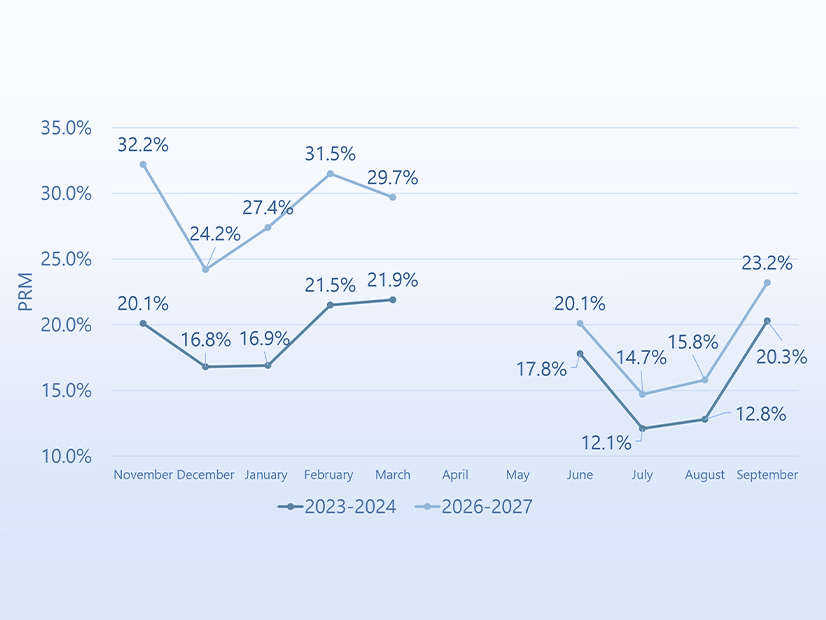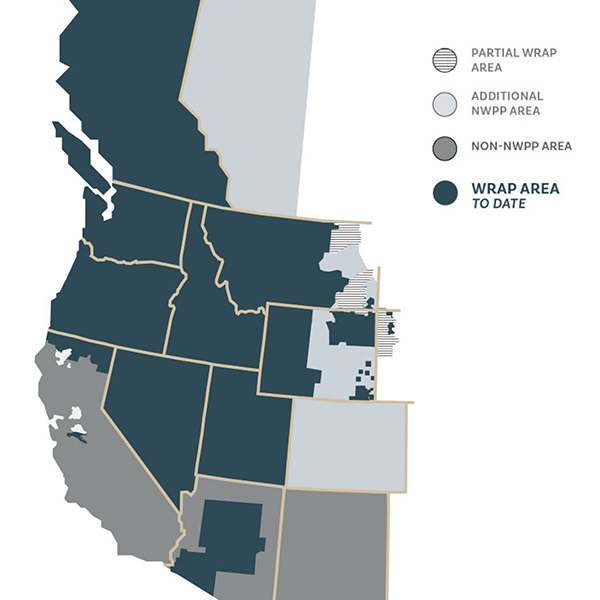
The Western Power Pool discussed the results of its first regionwide analysis of the Western Resource Adequacy Program (WRAP) with stakeholders Tuesday, including a look at the changing resource mix through 2027 and the need for higher planning reserve margins in the Desert Southwest.
“We are going to be an inch deep and a mile wide, so you should think about this as a survey or 101 overview of the metrics,” Ryan Roy, WPP director of technology, modeling and analytics, said while introducing the webinar.
“We’re going to talk a little bit about the loads and resources in the WRAP footprint,” Roy said. “We’re going to provide an overview of the installations and nameplate [capacity] for wind and solar, give you a feel for the number of units and number of plants that are out there.”
The WPP also provided an overview of the qualified capacity contributions (QCC) and effective load-carrying capability (ELCC) values for each resource class and of planning reserve margin values by region and month.
“This is relatively new for the Western Power Pool,” Roy said. “We’re working our best to ensure that the data is accurate, informative and timely. We’ve made a strong commitment to transparency. So, this is our first opportunity to talk about the broader regional results that we’re seeing in our modeling.”
Among the results:
For the Northwest, from 2023/24 through 2026/27, additional hydroelectric output will compensate for the retirement of most remaining coal plants, which will make up 2.07% of the resource mix in 2023 but .06% a few years later.
The Southwest, with a much different supply stack, will add solar and short-term battery storage from 2023 to 2027. The region will see a reduction in coal generation but still retain coal as a sizable portion of its resource mix, going from 24% in 2023/24 to 17% in 2026/27.
“The Northwest has planned resource retirements that can impact the capacity available to meet that one event day in a 10-year loss-of-load expectation, and the Southwest [will see a] significant increase in [solar and battery] resources.” Roy said. “They have very aggressive plan-to-build targets.”
An assessment of resource classes showed the WRAP footprint has a total of 146 wind plants with a nameplate capacity of 12,688 MW and 267 solar plants with 11,162 MW of capacity.
Peak loads in the Northwest top out at 41,502 MW during winter and in the Southwest at 37,434 in summer.
Planning reserve margins in the Northwest will not alter significantly in the four-year period covered in the analysis, but the Southwest will need to increase its PRM values to compensate for the infusion of variable solar resources, WRAP said. PRMs in the Southwest, for instance, will need to increase from 20% in November 2023 to 32% in November 2026, a slide in the presentation showed.
The webinar also included a detailed discussion of the ELCC and QCC of various resource classes by region and month.
‘Above the Line’
The presentation was a milestone for WRAP, the first broad-ranging resource adequacy program in the West.
WPP, formerly the Northwest Power Pool, started work on the effort two years ago amid concerns that Northwest utilities were increasingly and unknowingly drawing on the same shrinking pool of reliability resources.
Interest in the effort spread quickly to other areas of the West, and in a move that signified its expanding reach across the Western Interconnection, the Northwest Power Pool rebranded itself as the Western Power Pool earlier this year.
The program now has 26 participants from British Columbia to Arizona and east to South Dakota, including major players such as Arizona Public Service, the Bonneville Power Administration and PacifiCorp. CAISO, however, is not involved.
 WPP’s WRAP program has 26 participants covering much of the Western Interconnection. | NWPP
WPP’s WRAP program has 26 participants covering much of the Western Interconnection. | NWPPWPP and SPP plan to launch a “nonbinding” iteration of WRAP soon, one that lacks enforcement and penalties, and a binding phase in 2024, in which participants will be held accountable for failing to meet their expected resource contributions.
WPP’s board approved a tariff for WRAP last month and is hoping for FERC approval by the end of the year.
SPP, which WPP chose last year as a program operator, provided the modeling and metrics discussed Tuesday.
“Current WRAP participants are completing the non-binding Winter 2022-2023 and Summer 2023 forward-showing submittals using the just-released metrics as a guide to meet program requirements,” WPP said in a news release. “Participants will turn in workbooks to SPP for evaluation and feedback. WPP and SPP intend to release aggregate performance information from these non-binding submittals once complete.”
Stakeholder comments in Tuesday’s webinar included a question from Fred Heutte, senior policy associate at the Northwest Energy Coalition, asking organizers why they had not summarized data by participant, showing those that have or lack sufficient qualifying capacity, and whether participants will have access to that data going forward.
“Who’s above the line?” Huette said. “Who’s not, for example?”
Rebecca Sexton, WPP director of reliability, responded that public release of the data could impact purchase negotiations between parties.
“There’s just too much sensitivity about that,” Sexton said. “You can imagine that if someone is being shown to the region as slightly deficient, that that just opens a whole can of worms with respect to how their conversations with folks go who might have some capacity they are willing to sell them.
“So, that sensitivity is one we want to be really aware of. We don’t want to have a negative impact on their participation in any market, bilateral now, certainly, or bilateral in the future as well, as we think about this forward procurement, so we will not be sharing that information.”

